Defining Collage

The The word "collage" Is a French term "coller" meaning to "glue or paste." It is the adhering of flat materials to a flat surface, and many 20th century artists incorporated collage into their paintings and other works. Collage has been used for centuries, but artists also incorporate three-dimensional elements as well. These art works can be considered collage, assemblage or mixed media. Found papers and other materials, layering and textures can create quite aesthetic pieces, while also implying a social, political or personal statement.
Incorporating Line, (straight, curved, angle, circle or dot); the Elements of Design, (line, shape, color, pattern, value, movement); and the Principles of Design, ( unity, balance, dominance, repetition, harmony, rhythm, contrast, gradation), can help bring about a cohesive composition. This is not to say one has to use every one in a piece, but enough to keep the eye of the viewer moving around the piece holding interest.
Making art need not be the exercise of a technician's skills. One's art can be also thoughtful play and a venue for creative flow.
There is design all around us both man-made and in Nature. One just needs to really "see" not merely "look." The artwork should be the synthesis of what is seen and felt, an emotion or sensation coming forth from the artist to the surface. The object is to turn raw objects into art. It is an intuitive process from the artist's subconscious and hand to the viewer's experience, knowledge and emotion - the Third Eye of the artist to the Third Eye of the viewer. What one experiences in the world or envisions his/her world to be, is emotionally dictated from the artist to the viewer. What appears hostile and angry with a color splashed in dominance across a canvas to the artist, may bring a lively balance of beauty to the viewer. One can never know.
How does one "learn" art and bring the elements of what one knows? Play and practice, practice, practice and more play. Go to the child within and forget the mundane grownup things. (There's plenty of time for that after a couple of hours of artist time in practice and play). "See" and then look closer. Try using the Design Elements and then a few of the Design Principles. Mix it up and create playful things that make you feel good. Shape it, mold it, and don't think that every piece you create will be a masterpiece! You will always find fault with your work in ways that know one else will ever see. So let yourself go! Remember the words of artist Bob Ross? He would always say, "There are no mistakes, only happy accidents."
Collage ~ The technique of gluing or pasting to a surface
or substrate to create two-dimensional piece of art.
Assemblage ~ (As sem blage) ~ The technique of assembling
objects then adhering to a substrate in a three-
dimensional way.
Mixed Media ~ An artwork that combines more than one medium to create a
composition.
Mediums ~ 1 . An artist's choice of paints, pencils, pastels, textures, etc.
2 . Products used for adhering papers or objects to surface and also for coating and
varnishing. These include Gloss, Mat, gels: pastes such as YES, PVA and Wheat paste, E6000, etc.
to name a few. Liquitex and Golden products do a suitable job and provide products with UV protection.
Acid Free ~ Materials that should not break down and yellow overtime. Generally referred to with paper products and art materials
paper products and art materials such as inks.
Fugitive Color ~ Color that disappears over time, such as inexpensive artist inks, ink jet and laser and magazine inks.
Photomontage ~ The use of photographs or pieces of photograhed material adhered to the surface.
Brulage ~ Burning elements of the collaged piece or pieces.
Fumage ~ Fumage is a technique in which impressions are made by the smoke of a candle or kerosene lamp on papers or
canvas paintings. Dali referred to his technique as "sfumato".
Frottage ~ Rubbing to obtain texture.
Froissage ~ Crumbling of papers for the collage.
Digital Collage ~ Creating art through the medium of technology/the computer software/programs.
SUGGESTED
READING
The Creative Artist & Collage
by Nita LeLand
Collage: A Complete Guide for Artists Anne Brigadier
Collage by Jonathan Talbot
Collage Techniques by Gerald Brommer
Art Effects by Jean Drysdale Green
Drawing With Children by Mona Brooks
Art Festivals by Maria Arango